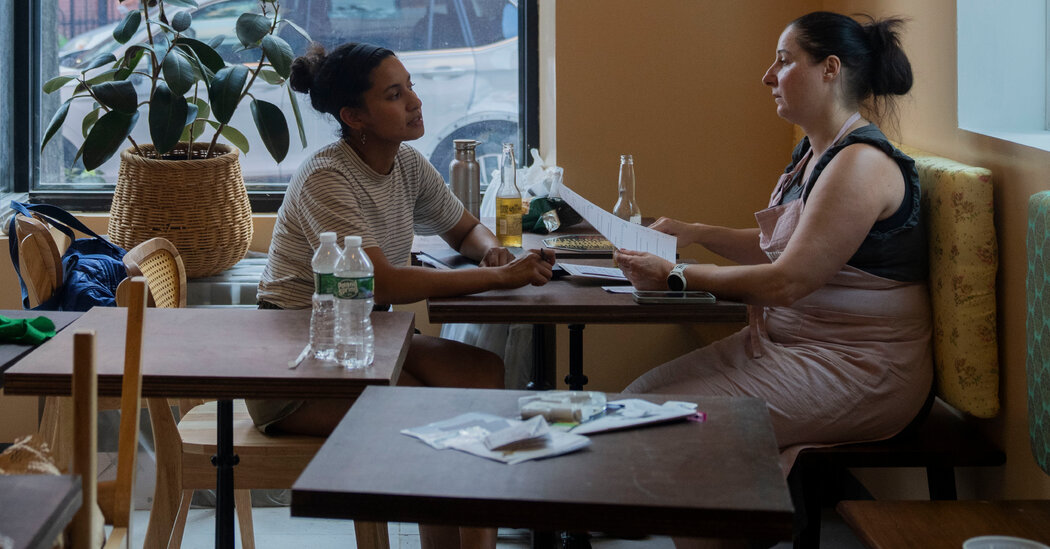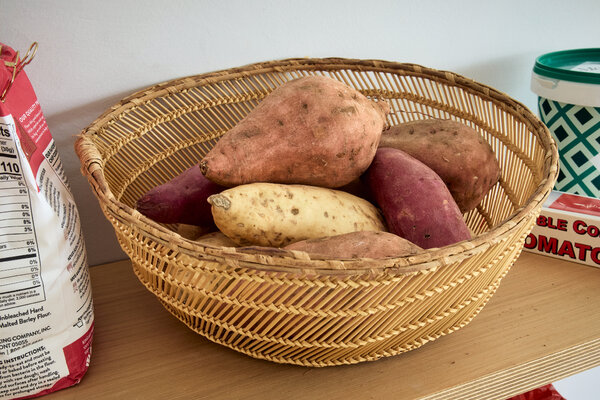September 2024
Mouleena Khan, 35, feels stuck in her midlevel job at a health care technology company. Encouraged by her boyfriend, she quits and begins planning a restaurant.
She’s imagined this move for a long time, but felt daunted by the process and her lack of any experience working in one, or even cooking.
What she does have is a personality — upbeat, organized and unshakable — well-suited for the unpredictability of restaurant work. She decides to put a big chunk of her savings into the project, and understands there’s a good chance she’ll fail.
Finding her other half
Over brunch in December, Mouleena asks her friend Aleks Jeune, 45, a no-nonsense pragmatist who runs the Brooklyn coffee shop Chez Alex, if she’ll partner on the restaurant. Aleks, who immigrated to New York from Poland in 2002, wants to flex her cooking skills. She agrees on the spot.
What’s the big idea?
Mouleena’s vision is the kind of restaurant she’s always wanted in her Bedford-Stuyvesant neighborhood: a casual, all-day cafe serving food inspired by her Bengali heritage, where diners can drop in without a reservation — “a place that people in the neighborhood go to that is warm and friendly when you don’t want to cook for yourself.”
Naming the restaurant is the easy part. Cheeni means sugar in Bengali and Hindi, and she likes its melodic sound.
The money conversation
With an M.B.A. from the University of Chicago, Mouleena knows how to pitch people on an idea.
She and Aleks draw up a list of their selling points: They know the neighborhood well. Brooklyn doesn’t have many Indian restaurants in the middle space between takeout and fine dining. The borough’s casual, sit-down restaurants are often hard to get into.
To gain experience and a little cash, in January Mouleena starts bartending at Moot Bar in Bed-Stuy. She gets regulars excited about her plan, and learns to pour a beer with just the right amount of foam.
Mouleena and Aleks start discussing a business plan over dinner at Dhamaka, an Indian restaurant in Manhattan.
They agree to invest $30,000 of their own money, and raise $100,000 from friends and family. But their emailed pitch to about 25 potential investors in March elicits a tepid response: Many friends are buying houses or having children.
Eventually, eight investors come on board, including Mouleena’s father, Pradip Khan, who puts up $15,000, and her sister, Alisha Khan, with $10,000, along with several friends who invest $2,000 to $10,000.
This brings the women’s budget to $176,000, including $59,000 they can put on their two business credit cards with no interest.
FEBRUARY 2025
With cash in their coffers, Mouleena and Aleks are ready for the next big step: finding a space. They decide to open in early summer.
Projected opening date: June 1
Landing an affordable New York rental is notoriously tricky. With a budget of $4,000 to $6,000 a month, the partners hope for a space with an ample kitchen and room to seat 30, on a street with lots of foot traffic and few other wine bars or cafes. They’d also like to walk to work.
It’s winter, and the pickings online are slim. But they find three strong contenders.
ABig, Bright and Costly
485 Tompkins Avenue
$7,100/month
Aleks came across this space while jogging. It’s brand-new, with nice light, a backyard, a spacious basement and lots of pedestrian traffic. It lacks a kitchen, so the women will have to build one. And the rent is over their budget.
BTurnkey With a Catch
564 DeKalb Avenue
$5,500/month, plus a one-time payment of $250,000
Formerly a neighborhood restaurant called Baron’s, this feels the most ready of the three to move right into. The current renter has even offered to transfer the liquor license to Mouleena and Aleks.
But the renter runs a special-events business and wants to continue using the kitchen. He’ll cover some of the rent, but asks for another $250,000, since he has already paid to convert the space for a restaurant.
CCozy and Affordable
395 Nostrand Avenue
$6,042/month
This charming, brick-walled space used to house a bar called Corners, and the price is right. But the hardwood floors need finishing, natural light is minimal and Mouleena finds the low-ceilinged basement “a little creepy.” Still, the money saved on rent would allow her to invest more in sprucing up the room.
Which did they pick?
Select the space you think they chose.
Now, the paperwork
Having spent years navigating the health care system, Mouleena easily handles, and even enjoys, filling out all the forms.
She takes a food-safety course so she can get a food handler’s license. She and Aleks find a contractor to build the kitchen exhaust; he introduces them to an engineer to file for the landmark approvals. Mouleena isn’t even bothered when the State Liquor Authority grants and then rescinds the wine license over a minor technicality. (Eventually, it’s approved.)
It’s construction time
Meeting with contractors, Mouelena and Aleks realize the buildout will cost more than $200,000, which they don’t have.
So they turn to two workers who won’t cost a bit: their romantic partners.
They’ll erect walls in the back of the place to house the kitchen, then build the kitchen, bar and custom benches attached to the walls.
A.J. and T.J. create the kitchen by installing two walls in the back of the restaurant. Easy enough.
Or not so easy: A.J. and T.J. spend all day building the bar out of birch from Home Depot. But to sit at it comfortably, you’d have to be more than six feet tall, like the two men. That sets off an argument with the women, but ultimately they rebuild the bar.
A thief in the night! Someone breaks in, sleeps behind the bar, takes two circular saws – and defecates on the floor. A.J. and T.J. promptly install a security gate in the basement.
Plumbing is a hassle. The women find a plumber to set up the sinks and dishwasher, but he charges $14,000 and takes his sweet time.
May 2025
As the space starts to take shape, Mouleena and Aleks turn to the décor, but a June 1 opening date is now looking impossible.
New opening date: June 15
In New York, design budgets for some restaurants can stretch well into six figures. These partners have just $14,000. Their goal is to evoke Mouleena’s colorful family home in Kolkata, India, which has a breezy feel, like a veranda. With their budget, their approach is decidedly D.I.Y.
The women shop for paint in earth tones – pale yellows, browns and dark greens. Eyeing a dark yellow, Aleks says, “This one looks like vomit.”
Who ends up painting the restaurant?
Who else but A.J. and T.J.?
Mouleena and her sister, Alisha, spend a weekend at home upholstering bench cushions, using their mother’s old saris.
Mouleena makes a mood board full of details inspired by her Kolkata memories: elegant archways, floral wallpaper and pendant lights. Much of it is beyond her price range, so she’ll have to be creative.
Mouleena and Aleks spend hours trawling through vintage stores like Mother of Junk in Williamsburg and Bedford Galleries in Bed-Stuy, where they find inexpensive rattan chairs and paintings that match the hues of the benches.
The streets of Brooklyn are a trove of discarded gems that can be used to decorate. At a construction site, Mouleena finds an impressive mirror and an Instant Pot.
Aleks makes a rare discovery at a repair shop: a $20,000 La Marzocco espresso machine from Italy, selling used for $6,000. The two men carry it over to Cheeni.
Another budget-friendly idea from Aleks: pasting faces of famous South Asians, including the actors Kumail Nanjiani and Mindy Kaling, on the bar.
Listening to the French Open on a phone, A.J. and T.J. construct tables, hang paintings and install the lights outside.
It’s all about the brand
The restaurant already has a name. But how to get someone walking by or scrolling Instagram to quickly understand what the place is all about — and stop in?
Mouleena has an idea for a mascot: a monkey holding a wine glass. She reaches out to a friend who runs a creative agency. The quote that comes back is $25,000 for a logo, menu design and signage. Too much. Back to the drawing board.
A friend, Rajib Mitra, who is a product manager but not a designer, asks ChatGPT to draw a logo, then changes the fonts to look cleaner.
Another friend, Nick Potter, offers to try his hand at a logo for just $200. His first try is stylized and architectural, but not quite bold enough for Mouleena and Aleks.
His second option is colorful, but too busy.
The women love Nick’s rendition of the mascot, but decide to pair it with Rajib’s fonts, creating a logo that’s playful but direct.
Mouleena creates an Instagram account for Cheeni. But she barely uses her personal account, and Aleks doesn’t use social media at all. So Mouleena spends most of a day watching YouTube videos to learn how to create a multipaneled Instagram post.
The women decide not to hire anyone to run publicity and marketing — they can’t afford it, and are hoping word of mouth will draw people in. They’ll have to do all their own social media.
June 2025
The moment has come for the most critical decisions of all: what to serve and whom to hire. The opening date is pushed back again to buy more time.
New opening date: July 1
From the start, Mouleena has wanted to serve Indian dishes with a nostalgic feel and some modern twists. But Aleks, who will head the kitchen, has never cooked Indian food.
They decide on a menu — a blend of traditional Indian dishes and a few items that remix classic Indian flavors.
Help wanted
It’s summer, when the city empties out. Aleks worries about finding enough people, so she and Mouleena cast a wide net, posting the job on Culinary Agents, Craigslist and Job Today.
Base pay is $20 an hour, higher than the $16.50 minimum wage in New York City, but allowing room for raises.
They hire 11 people. Over the next few weeks, they fire a cook who almost adds bacon to a vegan dish and a server who turns out to have little experience. That leaves nine.
July 2025
Could it be? Cheeni is finally ready for customers. For the first time, Mouleena and Aleks commit to an opening date and start the run-up.
Final opening date: July 16
The first hurdle is “friends and family,” as it’s known in the business — a dress rehearsal to allow the staff to practice for a sympathetic audience.
It’ll happen on July 12, a Saturday.
Just two days before the big night, the restaurant is still filled with trash, tools and dust. Aleks is trying to learn how to use an Instant Pot. Strangers keep throwing their trash onto Cheeni’s patio.
Somehow, everything comes together. The night arrives, and — as if magically — the place is clean, fully decorated and filled with flowers.
At 6 p.m. sharp, Mouleena’s parents show up. Her mother sobs tears of joy at seeing her old saris. “We were so scared,” she says. “But it is amazing.”
About 75 guests arrive around 6:30 p.m., including some who didn’t R.S.V.P. The atmosphere turns from calm to frenzied, fast.
All the orders seem to pile in at once. Charlie and Aleks are frying chop and stuffing phuchka, sweat streaming down their foreheads. Guests keep peeking into the kitchen to say hi. The exhaust system hasn’t been installed yet, so the air quickly thickens with smoke. At the pass, servers can’t tell which dish goes to which table.
Finally, the last orders reach the kitchen, and the cooks high-five. As the restaurant clears out, Aleks pours generous glasses of wine for everyone. The team is exhausted, but happy that the crowd seems to have loved the food. Still, a few changes need to be made: a longer curtain to cover the kitchen entrance, a sign marking the bathroom…
…and a better-organized dish station.
In total, the night brings in $2,337. Looking over the orders, Mouleena realizes the total should be closer to $5,000, Some guests apparently forgot to pay.
We’re open!
Mouleena and Aleks have four days to clean, fix the glitches and get Cheeni ready for its public opening.
They’ve installed a printer in the kitchen to create paper tickets that can help servers match each dish to a table.
Another improvement: a walkie-talkie system to connect the kitchen upstairs with the prep area downstairs.
The day of the opening, July 16, Aleks arrives at her coffee shop at 4.a.m. to bake pastries for Cheeni. They’re placed under a glass case, and at 8:02 a.m., the restaurant opens.
The rest of the day is slow. Because the owners didn’t advertise, there’s no sudden rush at the door. Those who do stop by are mostly from the neighborhood.
Despite the trickle of customers, the restaurant runs out of most dishes by 9 p.m.
And customers seem excited. “There is this trend of very similar restaurants opening up in this neighborhood, particularly new American,” says David Kirschberg, a designer who lives nearby. “It’s nice to have something that’s quite different.”
His girlfriend, Miriam Brito, who works in health-care communications, has been waiting for months for Cheeni to open. “I think this neighborhood embraces different,” she says. “I don’t think there’s such a thing as too different.”
August to October 2025
They did it! They opened a restaurant in less than eight months. Now for the hardest part: staying in business.
July and August are sleepy — but it’s summer, after all. Just before Labor Day, the owners meet with the staff to review the state of affairs. So far, Cheeni has broken even. To boost sales, they make some changes, including half-price glasses of wine during late-night hours and an increase to the price of chai, their best-selling item.
September brings a swift uptick. In the first week, revenue jumps 34 percent over the previous week, then 18 percent the week after that. Nights are still slow, but Mouleena and Aleks have built a small base of regular customers. They’ve started paying themselves the same $20 an hour they pay their employees.
Business may not be booming, but like so many restaurateurs, the two are already thinking about expansion. Maybe Manhattan, Aleks suggests, or another part of Brooklyn.
Would they really want to repeat the entire laborious process? It’s been exactly one year since Mouleena left her old job, where the salary was generous and the work predictable. Now, she’s not sure what next week will bring, much less next year. Still, she feels she’s just where she wants to be.
“I am way happier,” she says. “Totally worth it.”






